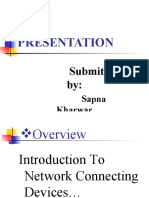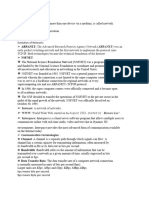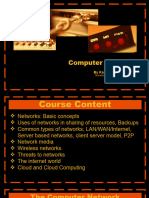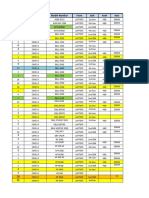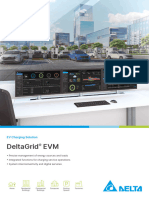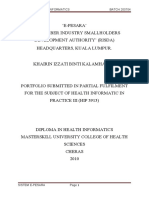INTERNET AND WEB
By Ajay Sir
INTRODUCTION TO COMPUTER NETWORKS
INTRODUCTION TO COMPUTER NETWORKS
A computer network is an interconnection among two or more computers or
computing devices.
• Such interconnection allows computers to share data and resources among each other.
• The network size may vary from small to large depending on the number of computers it connects.
• A computer network can include different types of hosts (also called nodes) like server, desktop,
laptop, cellular phones.
• Apart from computers, networks include networking devices like switch, router, modem, etc.
3
HOW DATA IS CARRIED OVER IN A NETWORK?
For communication, data in a network is divided into smaller chunks called
PACKETS.
• These packets are then carried over a network.
HOW ARE DEVICES CONNECTED IN A NETWORK?
Devices in a network can be connected either through wired media like cables or
wireless media like air.
• Each device that is a part of a network is known as NODE.
4
TYPES OF NETWORK
LAN (Local Area
Network)
MAN
TYPES OF NETWORK (Metropolitan
Based on the geographical area covered Area Network)
and data transfer rate, computer WAN (Wide Area
networks are broadly categorised as
Network)
6
LAN (LOCAL AREA NETWORK)
It is a network that connects nodes at a limited distance.
• The geographical area covered by a LAN can range from a single room, a floor, an office having one
or more buildings in the same premise, laboratory, a school, college, or university campus.
• These types of networks can be extended up to 1 km.
• Data transfer in LAN is quite high, and usually varies from 10 Mbps (called Ethernet) to 1000 Mbps
(called Gigabit Ethernet), where Mbps stands for Megabits per second. Ethernet is a set of rules that
decides how computers and other devices connect with each other through cables in a local area
network or LAN.
7
MAN (METROPOLITAN AREA NETWORK)
Metropolitan Area Network (MAN) is an extended form of LAN which covers a
larger geographical area like a city or a town.
• Data transfer rate in MAN also ranges in Mbps, but it is considerably less as compared to LAN.
• Cable TV network or cable based broadband internet services are examples of MAN.
• This kind of network can be extended up to 30–40 km.
• Sometimes, many LANs are connected together to form MAN
8
WAN (WIDE AREA NETWORK)
Wide Area Network (WAN) connects computers and others LANs and MANs, which
are spread across different geographical locations of a country or in different
countries or continents.
• A WAN could be formed by connecting a LAN to other LANs.
• Large business, educational and government organisations connect their different branches in
different locations across the world through WAN.
• The Internet is the largest WAN that connects billions of computers, smartphones and millions of
LANs from different continents.
9
NETWORK DEVICES
MODEM
Modem stands for ‘MOdulator DEMolulator’. It refers to a device used for
conversion between analog signals and digital bits.
• We know computers store and process data in terms of 0s and 1s. However, to transmit data from a
sender to a receiver, or while browsing the internet, digital data are converted to an analog signal
and the medium (be it free-space or a physical media) carries the signal to the receiver. There are
modems connected to both the source and destination nodes.
• The modem at the sender’s end acts as a modulator that converts the digital data into analog signals.
• The modem at the receiver’s end acts as a demodulator that converts the analog signals into digital
data for the destination node to understand.
11
ETHERNET CARD
Ethernet card, also known as Network Interface Card (NIC card in short) is a
network adaptor used to set up a wired network.
• It acts as an interface between computer and the network.
• It is a circuit board mounted on the motherboard of a
computer.
• The Ethernet cable connects the computer to the network
through NIC.
• Ethernet cards can support data transfer between 10 Mbps
and 1 Gbps (1000 Mbps).
• Each NIC has a MAC address, which helps in uniquely
identifying the computer on the network
12
REPEATER
A repeater is an analog device that works with signals on the cables to which it is
connected. The weakened signal appearing on the cable is regenerated and put
back on the cable by a repeater.
• Data are carried in the form of signals over the cable.
These signals can travel a specified distance (usually
about 100 m). Signals lose their strength beyond this limit
and become weak. In such conditions, original signals need
to be regenerated.
• Repeater is a device that regenerates the signals.
13
HUB
An Ethernet hub is a network device used to connect different devices through
wires.
• Data arriving on any of the lines are sent out on all the others.
• The limitation of hub is that if data from two devices come at the same time, they will collide
14
SWITCH
A switch is a networking device that plays a central role in a Local Area Network
(LAN). Like a hub, a network switch is used to connect multiple computers or
communicating devices.
• When data arrives, the switch extracts the
destination address from the data packet and
looks it up in a table to see where to send the
packet. Thus it sends signals to only selected
devices instead of sending to all.
• It can forward multiple packets at the same time.
• A switch does not forward the signals which are
noisy or corrupted. It drops such signals and asks
the sender to resend it.
15
ROUTER
A router is a network device that can receive the data, analyse it and transmit it to
other networks. A router connects a local area network to the internet.
• Compared to a hub or a switch, a router has advanced capabilities as it can analyse the data being
carried over a network, decide or alter how it is packaged, and send it to another network of a
different type.
• For example, data has been divided into packets of a certain size. Suppose, these packets are to be
carried over a different type of network which cannot handle bigger packets, in such a case, the data
is to be repackaged as smaller packets and then sent over the network by a router.
• A router can be wired or wireless.
• A wireless router can provide Wi-Fi access to smartphones and other devices. Usually, such routers also
contain some ports to provide wired Internet access.
• These days, home Wi-Fi routers perform the dual task of a router and a modem or switch. These
routers connect to incoming broadband lines, from ISP (Internet Service Provider), and convert them to
digital data for computing devices to process.
16
GATEWAY
Gateway is a key access point that acts as a “gate” between an organisation's
network and the outside world of the Internet. Gateway serves as the entry and
exit point of a network.
• Besides routing data packets, gateways also maintain information about the host network's
internal connection paths and the identified paths of other remote networks. If a node from one
network wants to communicate with a node of a foreign network, it will pass the data packet to
the gateway, which then routes it to the destination using the best possible route.
• For simple Internet connectivity at homes, the gateway is usually the Internet Service Provider that
provides access to the entire Internet.
• Generally, a router is configured to work as a gateway device in computer networks. A gateway
can be implemented as software, hardware, or a combination of both. This is because a network
gateway is placed at the edge of a network and the firewall is usually integrated with it.
17
NETWORK TOPOLOGIES
The arrangement of computers and other peripherals in a network is
called its topology.
MESH TOPOLOGY
In Mesh topology, each communicating device is connected with every other device
in the network.
• Such a network can handle large amounts of traffic since multiple nodes can transmit data
simultaneously.
• Also, such networks are more reliable in the sense that even if a node gets down, it does not cause
any break in the transmission of data between other nodes.
• This topology is also more secure as compared to other topologies because each cable between
two nodes carries different data.
• However, wiring is complex and cabling cost is high in creating such networks, and there are many
redundant or unutilised connections.
19
RING TOPOLOGY
In ring topology, each node is connected to two other devices, one each on either
side.
• The link in a ring topology is unidirectional. Thus, data can be transmitted in one direction only
(clockwise or counterclockwise).
20
BUS TOPOLOGY
In bus topology, each communicating device connects to a transmission medium,
known as bus.
• Data sent from a node are passed on to the bus and hence are transmitted to the length of the
bus in both directions. That means data can be received by any of the nodes connected to the bus.
• In this topology, a single backbone wire called bus is shared among the nodes, which makes it
cheaper and easy to maintain.
• Both ring and bus topologies are considered to be less secure and less reliable.
21
STAR TOPOLOGY
In star topology, each communicating device is connected to a central node, which
is a networking device like a hub or a switch.
• Star topology is considered very effective, efficient and fast as each device is directly connected
with the central device.
• Although disturbance in one device will not affect the rest of the network, any failure in the
central networking device may lead to the failure of complete network
22
TREE OR HYBRID TOPOLOGY
It is a hierarchical topology, in which there are multiple branches and each branch
can have one or more basic topologies like star, ring and bus.
• Such topologies are usually realised in WANs where multiple LANs are connected. Those LANs
may be in the form of ring, bus or star.
• In this type of network, data transmitted from source first reaches the centralised device and from
there the data passes through every branch where each branch can have link for more nodes.
23
THE INTERNET
The Internet is the global network of computing devices including
desktop, laptop, servers, tablets, mobile phones, other handheld
devices as well as peripheral devices such as printers, scanners, etc.
In addition, it also consists of networking devices such as routers,
switches, gateways, etc.
THE INTERNET
• Today, smart electronic appliances like TV, AC, refrigerator, fan, light, etc., can also communicate
through the Internet. The list of such smart devices are always increasing e.g., drones, vehicles,
door lock, security camera, etc.
• The Internet is evolving everyday. Computers are either connected to a modem through a cable or
wirelessly (Wi-Fi). A modem, be it wired or wireless, is connected to a local Internet Service
Provider (ISP) who then connects to a national network. Many such ISPs connect together forming a
regional network and regional networks connect together forming a national network, and such
country-wise networks form the Internet backbone.
• The Internet today is a widespread network, and its influence is no longer limited to the technical
fields of computer communications. It is being used by everyone in the society as is evident from
the increasing use of online tools for education, creativity, entertainment, socialisation and e-
commerce.
25
APPLICATIONS OF INTERNET
The World Wide
Web (WWW)
Electronic mail
APPLICATIONS OF INTERNET (Email)
Chat
Following are some of the broad areas
or services provided through Internet: Voice Over Internet
Protocol (VoIP)
27
THE WORLD WIDE WEB (WWW)
The World Wide Web (WWW) or web in short, is an ocean of information, stored
in the form of trillions of interlinked web pages and web resources. The resources
on the web can be shared or accessed through the Internet.
• Sir Tim Berners-Lee — a British computer scientist invented the
revolutionary World Wide Web in 1990 by defining three
fundamental technologies that lead to creation of web:
• HTML (Hyper Text Markup Language)
• URI (Uniform Resource Identifier)
• HTTP (Hyper Text Transfer Protocol)
28
HTML (HYPER TEXT MARKUP LANGUAGE)
HyperText Markup Language or HTML is a language which is used to design
standardised Web Pages so that the Web contents can be read and understood
from any computer across the globe. It uses tags to define the way page content
should be displayed by the web browser. Basic structure of every webpage is
designed using HTML.
29
URI (UNIFORM RESOURCE IDENTIFIER)
Uniform Resource Identifier or URI is a unique identifier to identify a resource
located on the web. URI identifies a resource (hardware or software) either by its
location or by its name or by both.
• URL is Uniform Resource Locator and provides the location and
mechanism (protocol) to access the resource. Examples of URI
identifying resources using location (i.e., URL) are:
• https://www.mhrd.gov.in
• http://www.ncert.nic.in
• http://www.airindia.in etc.
30
URL (UNIFORM RESOURCE LOCATOR)
URL is sometimes also called a web address. However, it is not only the domain
name, but contains other information that completes a web address.
• In the above URL:
• http is the protocol name, it can be https, http, FTP, Telnet, etc.
• www is a subdomain.
• ncert.nic.in is the domain name.
• Textbook is the path or directory.
• Textbook.htm is the resource.
These days it is not mandatory to mention protocol and subdomain while entering a
31 URL. The browser automatically prefixes it.
HTTP (HYPER TEXT TRANSFER PROTOCOL)
The HyperText Transfer Protocol is a set of rules which is used to retrieve linked
web pages across the web. It’s more secure and advanced version is HTTPS.
32
DIFFERENCE BETWEEN WEB AND INTERNET
Many people confuse the web with the Internet.
INTERNET WEB
The Internet as we know is the huge The web on the other hand is the
global network of interconnected interlinking of a collection of WebPages
computers, which may or may not have on these computers which are accessible
any file or webpage to share with the over the Internet.
world. WWW today gives users access to a
vast collection of information created
and shared by people across the world.
It is today the most popular information
retrieval system.
33
ELECTRONIC MAIL (EMAIL)
Email is the short form of electronic mail. It is one of the ways of sending and
receiving message(s) using the Internet. An email can be sent anytime to any
number of recipients at anywhere. The message can be either text entered directly
onto the email application or an attached file (text, image audio, video, etc.)
stored on a secondary storage. An existing file can be sent as an attachment with
the email, so no need to type it again.
• To use email service, one needs to register with an email service
provider by creating a mail account. These services may be free or
paid. Some of the popular email service providers are:
• Google (gmail)
• Yahoo (yahoo mail)
• Microsoft (outlook) etc.
34
ELECTRONIC MAIL (EMAIL)
Following are some of the common facilities available for an email user:
• Creating an email, attaching files with an email, saving an email as draft for
mailing later. Creating email is also termed as composing.
• Sending and receiving mail. Same email can be sent to multiple email addresses,
simultaneously.
• Sending the copy of mail, as carbon copy (cc) or blind carbon copy (bcc).
• Forwarding a received email to other user(s)
• Filtering spam emails
• Organising email in folders and sub folders
• Creating and managing email ids of the people you know.
• Setting signature/footer to be inserted automatically at the end of each email
• Printing emails using a printer or saving as files.
• Searching emails using email address or email subject text
35
CHAT
Chatting or Instant Messaging (IM) over the Internet means communicating to
people at different geographic locations in real time through text message(s).
• it is now possible to send image, document, audio, video as well
through instant messengers.
• Applications such as WhatsApp, Slack, Skype, Yahoo Messenger,
Google Talk, Facebook Messenger, Google Hangout, etc., are
examples of instant messengers.
• Some of these applications support instant messaging through all the
modes — text, audio and video.
36
VOIP (VOICE OVER INTERNET PROTOCOL)
Voice over Internet Protocol or VoIP, allows us to have voice call (telephone service)
over the Internet, i.e., the voice transmission over a computer network rather than
through the regular telephone network. It is also known as Internet Telephony or
Broadband Telephony.
• To avail the phone service over the Internet, we need to have an
Internet connection with reasonably good speed.
• Two advantages of VOIP are:
• These services are either free or very economical
• VoIP call(s) can be received and made from any place having Internet
access.
• The only disadvantage of VoIP is that its call quality is dependent on
Internet connection speed. Slow Internet connection will lead to poor
quality voice calls.
37
WEBSITE
WEBSITE
A website in general contains information organised in multiple pages about an
organisation. A website (usually referred to as a site in short) is a collection of web
pages related through hyperlinks, and saved on a web server.
• A visitor navigates from one page to another by clicking on
hyperlinks.
• Also, all the pages of a website are integrated under one domain
name and have a common theme and template.
39
PURPOSE OF A WEBSITE
A website’s purpose is to make the information available to people at large.
• A website is a means that helps to communicate with people in a specific,
transparent and user friendly manner.
• A website should be user friendly and provide information to users with
minimum efforts.
• website should be designed keeping in mind different categories of
people that will be visiting the site.
• Some of the common purposes for which websites are designed are listed
below:
• Selling products and delivering services
• Posting and finding information on the internet
• Communicating with each other
• Entertainment purposes
• Disseminating contents and software
40
WEB PAGE
WEB PAGE
A web page (also referred to as a page) is a document on the WWW that is
viewed in a web browser.
• Basic structure of a web page is created using HTML (HyperText
Markup Language) and CSS (Cascaded Style Sheet).
• A web page is usually a part of a website
• Scripts make a web page interactive. JavaScript is the most popular and
commonly used scripting language. However, Python and PHP are also
used to apply scripting on a web page.
• The first page of the website is called a home page. It generally contains
information and links to all the related web pages.
42
STATIC AND DYNAMIC WEB PAGES
A web page can be static or dynamic.
Static Web Page Dynamic Web Page
A static webpage is one whose content always A dynamic web page is one in which the content of the
remains static, i.e., does not change for person to web page can be different for different users.
person.
No additional processing is performed on the page Before sending the requested web page, the server
may perform some additional processes like getting
information from the database, updating date and
time, updating weather information, etc. The content of
such pages changes frequently.
Static web pages are generally written in HTML, Dynamic web pages can be created using various
JavaScript and/or CSS and have the extension .htm languages such as JavaScript, PHP, ASP.NET, Python,
or .html. Java, Ruby, etc.
43
WEB SERVER
WEB SERVER
A web server is used to store and deliver the contents of a website to clients such
as a browser that request it.
• When talking about a web server as computer hardware, it stores web server software
and a website’s contents (HTML pages, images, CSS stylesheets, and JavaScript files).
• The server needs to be connected to the Internet so that its contents can be made
accessible to others.
• When talking about a web server as a software, it is a specialised program that
understands URLs or web addresses coming as requests from browsers, and responds to
those requests.
• The web browser from the client computer sends a request (HTTP request) for a page
containing the desired data or service. The web server then accepts, interprets, searches
and responds (HTTP response) to the request made by the web browser. The requested
web page is then displayed in the browser of the client. If the server is not able to
locate the page, it sends a page containing the error message (Error 404 – page not
45 found) to the client’s browser.
HOSTING OF A WEBSITE
WEB HOSTING
Web hosting is a service that allows us to put a website or a web page onto the
Internet, and make it a part of the World Wide Web. To host a website, follow the
steps given below:
• Select the web hosting service provider that will provide the web server space as well as related
technologies and services such as database, bandwidth, data backup, firewall support, email
service, etc. This has to be done keeping in mind the features and services that we want to offer
through our website.
• Identify a domain name, which best suits our requirement, and get it registered through domain
name Registrar.
• Once we get web space, create logins with appropriate rights and note down IP address to
manage web space.
• Upload the files in properly organised folders on the allocated space.
• Get domain name mapped to the IP address of the web server.
The domain name system (DNS) is a service that does the mapping between domain name and IP
address. When the address of a website is entered in a browser, the DNS finds out the IP address of the
47 server corresponding to the requested domain name and sends the request to that server.
BROWSER
BROWSER
A browser is a software application that helps us to view the web page(s). Some of
the commonly used web browsers are Google Chrome, Internet Explorer, Mozilla
Firefox, Opera, etc.
• A web browser essentially displays the HTML documents which may
include text, images, audio, video and hyperlinks that help to
navigate from one web page to another.
49
ADD-ONS AND PLUG-INS
Add-ons and plug-ins are the tools that help to extend and modify the functionality
of the browser. Both the tools boost the performance of the browser, but are
different from each other.
Add-ons Plug-ins
An add-on is not a complete program and so is used A plug-in is a complete program or may be a
to add only a particular functionality to the browser. third-party software.
An add-on is also referred to as extension in some
browsers.
Adding the functionality of a sound and graphics card For example, Flash and Java are plug-ins.
is an example of an add-on.
An add-on is added only in the browser. This can not A plug-in is a software that is installed on the host
be used by other applications. computer and can be used by the browser for
multiple functionalities and can even be used by other
applications as well.
50
COOKIE
A cookie is a text file, containing a string of information, which is transferred by the
website to the browser when we browse it.
• This string of information gets stored in the form of a text file in the
browser.
• The information stored is retransmitted to the server to recognise the
user, by identifying pages that were visited, choices that were made
while browsing various menu(s) on a particular website.
• It helps in customising the information that will be displayed, for
example the choice of language for browsing, allowing the user to
auto login, remembering the shopping preference, displaying
advertisements of one’s interest, etc.
51
ARE COOKIES HARMFUL?
Cookies are usually harmless and they can’t access information from the hard disk
of a user or transmit virus or malware.
• It is the browser on our computer which stores and manages the
cookies.
• However, viruses can also be tricked as cookies and cause harm to a
computer.
• One can disable cookies by changing the Privacy and Security
settings of our browser.
52
THANK YOU
BY AJAY SIR
















